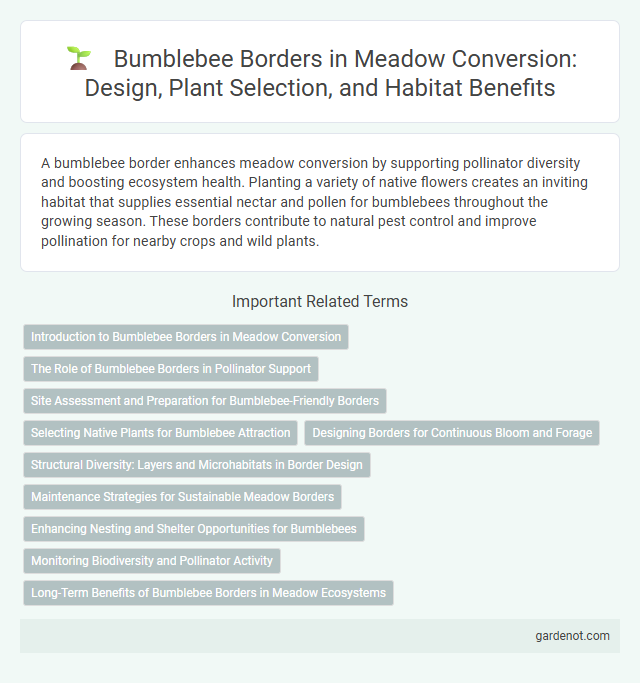A bumblebee border enhances meadow conversion by supporting pollinator diversity and boosting ecosystem health. Planting a variety of native flowers creates an inviting habitat that supplies essential nectar and pollen for bumblebees throughout the growing season. These borders contribute to natural pest control and improve pollination for nearby crops and wild plants.
Introduction to Bumblebee Borders in Meadow Conversion
Bumblebee borders play a vital role in meadow conversion by providing essential habitats and food sources for bumblebee populations. Incorporating diverse flowering plants that bloom throughout the growing season supports pollination and enhances biodiversity within meadow ecosystems. Properly designed bumblebee borders contribute to ecological balance and strengthen the resilience of converted meadow landscapes.
The Role of Bumblebee Borders in Pollinator Support
Bumblebee borders enhance pollinator support by providing diverse floral resources that sustain bumblebee populations throughout their active seasons. These borders increase habitat connectivity and foraging opportunities, promoting pollination efficiency and biodiversity in meadow ecosystems. Incorporating native flowering plants in bumblebee borders also helps mitigate the effects of habitat loss and pesticide exposure on pollinator health.
Site Assessment and Preparation for Bumblebee-Friendly Borders
Site assessment for Bumblebee-friendly borders involves detailed analysis of soil quality, existing flora, and local Bumblebee species diversity to ensure optimal habitat conditions. Preparation includes selecting native, nectar-rich flowering plants that bloom sequentially to provide continuous forage while avoiding pesticides and maintaining natural nesting sites. Proper site preparation enhances pollinator attraction and supports sustainable Bumblebee populations by fostering a balanced meadow ecosystem.
Selecting Native Plants for Bumblebee Attraction
Selecting native plants such as Echinacea purpurea, Monarda fistulosa, and Solidago spp. enhances bumblebee attraction by providing essential nectar and pollen resources. These species bloom sequentially from spring through fall, ensuring continuous forage opportunities that support bumblebee foraging and colony growth. Incorporating diverse native flowering plants also improves habitat quality, promoting bumblebee population stability and meadow ecological resilience.
Designing Borders for Continuous Bloom and Forage
Designing a bumblebee border for continuous bloom and forage involves selecting a diverse mix of native wildflowers and flowering shrubs that bloom sequentially from early spring to late fall, ensuring consistent nectar and pollen supply. Key species include lavender, coneflower, and milkweed, which support bumblebee foraging throughout multiple growth stages. Incorporating structural variety with layered plant heights promotes habitat diversity, enhancing pollinator activity and overall meadow ecosystem health.
Structural Diversity: Layers and Microhabitats in Border Design
Bumblebee borders enhance structural diversity by incorporating multiple layers of vegetation, including ground cover, low-growing herbs, and taller flowering plants, creating varied microhabitats essential for different bee species. This layered design supports nesting opportunities, foraging efficiency, and protection from predators and adverse weather, promoting healthy bumblebee populations. Diverse plant heights and densities facilitate pollinator movement and maximize nectar and pollen availability throughout the season.
Maintenance Strategies for Sustainable Meadow Borders
Effective maintenance strategies for bumblebee borders in meadow conversions prioritize periodic mowing to prevent scrub encroachment while allowing floral diversity to thrive, enhancing foraging resources for bumblebee populations. Incorporating rotational cutting schedules supports continuous bloom periods, crucial for sustaining bumblebee activity throughout the seasons. Soil monitoring and minimal chemical intervention further promote native plant resilience and a healthy habitat tailored for pollinator conservation.
Enhancing Nesting and Shelter Opportunities for Bumblebees
Bumblebee border plantings designed with native wildflowers and grasses significantly boost nesting and shelter opportunities for bumblebees by providing essential forage and protective habitats. Incorporating structural diversity through tall flowering plants and dense ground cover creates optimal microclimates for nesting queens and colonies. Studies show that strategically placed meadow conversions increase local bumblebee populations by up to 40%, supporting pollination and biodiversity in agricultural landscapes.
Monitoring Biodiversity and Pollinator Activity
Bumblebee borders are critical for monitoring biodiversity by providing habitat and food sources that support diverse pollinator populations. Regular observation of pollinator activity within these borders helps track species diversity, abundance, and behavior, offering valuable data for ecological health assessments. These insights contribute to optimizing meadow conversion strategies, enhancing ecosystem services and promoting sustainable pollination.
Long-Term Benefits of Bumblebee Borders in Meadow Ecosystems
Bumblebee borders significantly enhance meadow ecosystems by promoting pollination diversity and supporting sustainable biodiversity over time. These borders create vital habitats that increase forage availability and nesting opportunities, leading to stronger bumblebee populations essential for ecosystem resilience. Long-term benefits include improved crop yields and natural pest control, reinforcing ecological balance within agricultural landscapes.
Bumblebee border Infographic

 gardenot.com
gardenot.com